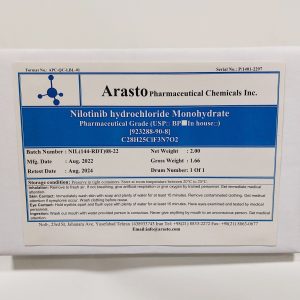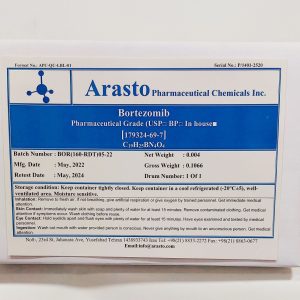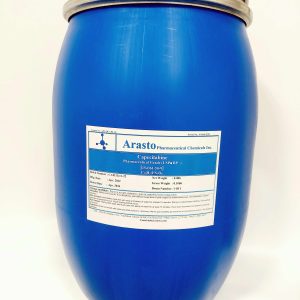Description
Description
(In-house)
- Drug Substance General Information (ICH 3.2.S.1)
1.1. Nomenclature (ICH 3.2.S.1.1)
International non-proprietary name: Sunitinib Malate (Brand Name: Sutent, Pfizer, USA)
Compendial name: Sunitinib Malate
Chemical name: N-(2-diethylaminoethyl)-5-[(Z)-(5-fluoro-2-oxo-1H-indol-3-ylidene) methyl]-2,4-dimethyl-1H-pyrrole-3-carboxamide S-Malate
Arasto’s code: SUN
CAS Registry Number: [341031-54-7]
1. Drug Substance General Information (ICH 3.2.S.1)
1.2 Structure (ICH 3.2.S.1.2)

Empirical formula: C22H27FN4O2.C4H6O5
Molecular Weight: 532.57 g/mol
- Drug Substance General Information (ICH 3.2.S. 1)
1.3. General Properties (ICH 3.2.S.1.3)
Sunitinib Malate is a yellow to orange crystalline substance. It is soluble in water and polar organic solvents. Sunitinib Malate is orally administered for the treatment of advanced renal cell carcinoma, gastrointestinal stromal tumor (GIST), well-differentiated pancreatic neuroendocrine tumors. pKa range of 8.95 (http://www.medsafe.govt.nz/profs/datasheet/s/ Sutentcap.pdf). Its Log P has been reported 3.2 (http://www.druglead.com/cds/sunitinib.html). Sunitinib Malate is relatively stable in acid and base (see Stability Studies). LD50 of Sunitinib Malate has been reported (>500 mg/kg oral rat; >500 mg/kg oral mouse; >500 LD50mg/kg oral dog, http://ctep.cancer.gov/branches/pmb/msds/736511-Sunitinib_malate_SU011248_L-malate_SutentAugust_30_2005.pdf).
The determination of purity and assay of APIs require comparison of the product with their respective Reference Standards (RS) and Related Compounds (RC or known impurities). Accordingly, ICH regulations on the purity and assay of reference standard and related compounds are clearly defined and must be followed by drug substance and drug product manufacturers.
According to ICH Q7, 11.1 there are 3 types of standards. This is summarized in the following chart and discussed in detail below.

The impurities provided in the following table represent Secondary Reference Standards (SRS) that are prepared in-house by synthesis or by isolation. Each SRS has undergone extensive characterization (IR, UV, 1HNMR, 13CNMR. Mass Spec) and determination of its purity and assay (HPLC). For specification of the SRS of those products that have a monograph, the SRS is compared with a pharmacopoeia Primary Reference Standard (UV, HPLC retention time). For specification of those products that do not have a monograph (known as House Primary Standard), we compare their UV ε or ג /max, IR major absorptions, 1HNMR d(ppm), 13CNMR d(ppm) or HPLC retention time with values reported in the chemical literature for these compounds.

5. Primary and Secondary Reference Standard (ICH 3.2.S.5)
5.1. Active Pharmaceutical Ingredient
Primary Reference Standard for sunitinib is not available from United States Pharmacopoeia. We will use a House Primary Standard (previously referred to as Working Standard) for direct control of all batches of sunitinib.
As per ICH (Q7, 11.1) and ICH (Q6, 2.11, 3.2, 3.3) House Primary Standards, which include the API and its Related Compounds, must be examined for their proof of structure (characterization), assay and purity and specification (identification by comparison). Furthermore, ICH Guideline on the Preparation of Common Technical Document (Q4M) requires that the data obtained from characterization, assay and purity and specification must be included in section 3.2.S.3.2 for Related Compounds (already discussed in that section) and section 3.2.S.5 of the DMF for the API. To this end, the House Primary Standard of the API sunitinib has undergone extensive characterization (UV, IR, 1 H NMR, 13C NMR, Mass Spec) to assure its structure, assay and purity (HPLC and/or titration) and specification.
The House Primary Standard for sunitinib was produced from a released batch of sunitinib by subjecting it to an additional crystallization from the final solvent system used in the production of the API to avoid the possibility of other polymorph formation. It was crystallized twice more to ensure high level of purity.
SPECIFICATION OF ANALYSIS
| Product: Sunitinib malate | CAS No.: 341031-54-7 | Spec. No.: APC-QC-SPEC-393-00 | ||
| Issue Date: Apr, 2023 | Valid up to: Apr, 2024 | Reference: In-house | ||
| Tests | Specifications | |||
| Appearance | A fine orange-brown powder. | |||
| Solubility | Slightly Soluble in methanol and water. Insoluble in methylene Chloride. | |||
| Identification | Compare the retention time of the major peak in the chromatogram obtained with the sample preparation to that in the chromatogram of the standard preparation as obtained in the test for Assay. | |||
| Loss on drying | NMT 0.5% (at 105°C for 3 hour) | |||
| Residue on ignition | NMT 0.1% | |||
| Residual solvents | Methanol: Max 3000 ppm (Class II) Ethanol: Max 5000 ppm (Class II) Acetone: Max 5000 ppm (Class III) Dichloromethane: Max 600 ppm (Class II) Toluene: Max 890 ppm (Class II) | |||
| Related substances (HPLC) | Sunitinib Related Compound A: NMT. 0.2% (5-Fluoro-2-oxindole) Sunitinib Related Compound B: NMT. 0.2% (N-(2-(Diethyl amino) ethyl)-5-formyl-2,4-dimethyl-1H-pyrrole-3-carboxamide) Each Unknown Impurity: NMT. 0.1% Total Impurities: NMT 0.5% | |||
| Assay (HPLC) | Between 98.0% to 102.0% | |||
| Prepared by: M. Shahbazi, B.Sc.Chem. | Checked by: A. Forghani, B.Sc.Chem. | |||
| Approved by: F. Javadizadeh, M.Sc.Chem. | ||||
| Storage: Store in cool place. Keep container tightly closed in a dry and well-ventilated place. | ||||





